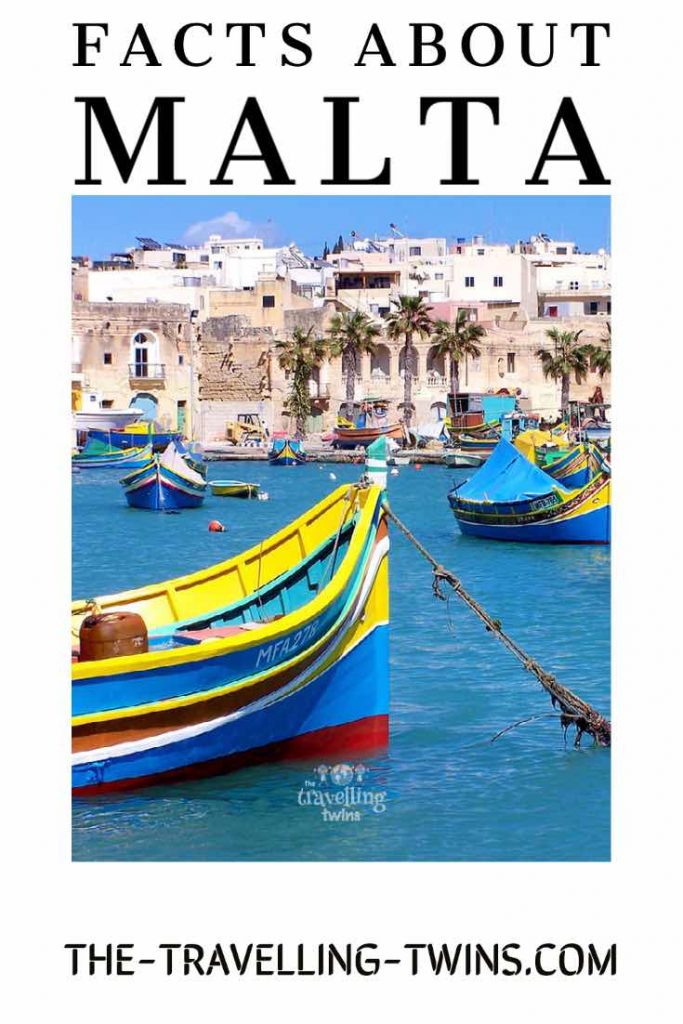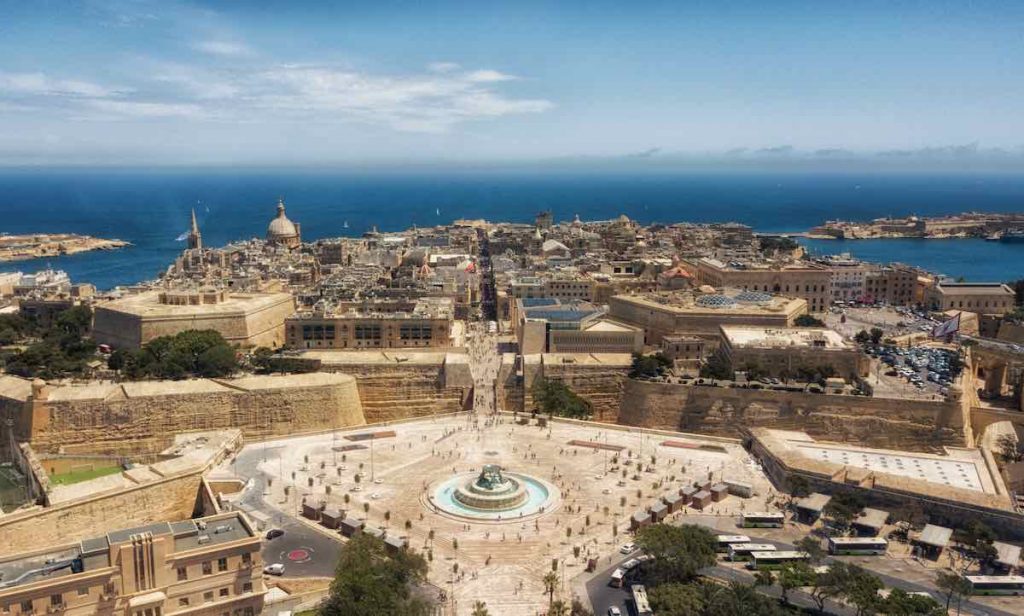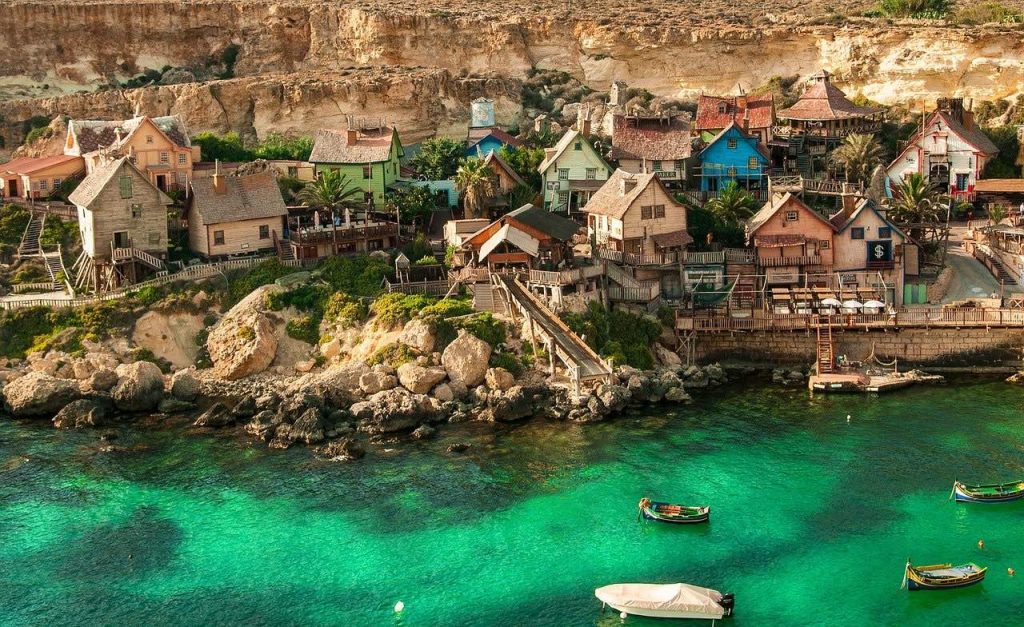Malta is a small island nation located in the Mediterranean sea. I had the pleasure of living in Malta for over two years explore it and learn about its culture. This blog post contains all you need to know about Malta: one of the smallest countries in the world and the warmest countries in Europe. Read and enjoy Interesting Facts about Malta.

Where is Malta? Location and population of Malta
Malta is located in the Mediterranean sea, just off the coast of Africa, on an archipelago consisting of five islands. The three bigger ones are inhabited and are named Malta, Gozo and Comino. The other two are Cominotto and Filfla.
Malta is the world’s tenth smallest country, with an area of just 316 square kilometres or 123 sq miles. It’s about or twice as big as Washington DC.
The total population is just 450,000 or 0.12% of Europe’s population, making it one of the most densely populated countries globally, with a population density of around 2,650 people per square kilometre.
The History of Malta
Malta has a long and fascinating history. The islands were ruled by many empires starting with the Phoenicians in 9th century BC, Carthaginian ( 6th century BC), Roman in (218 BC) and Byzantine from 395 AD. In 870 AD, Arabs conquered and ruled Malta for a few centuries until the arrival of Normans in 1127. At that time, Christian religions took over again, and the Maltese language we know now started to develop. In the 16th century, Crusading Knights came to Malta and had an enormous effect on the island’s development, and Italian became the official language.
In 1798 Napoleon Bonaparte came to the Maltese islands, and the French captured Malta from the Knights. The French only ruled for two years as Maltese asked the English for help, Lord Nelson came and drove out the French, and Malta became part of the British Empire.
In 1964 Malta gained independence from the Empire to join the British Commonwealth of Nations. Queen Elizabeth II as Head of State, until 1974 when Malta became a republic after 164 years of British rule
Malta joined the European Union on 1st May 2004 together with nine other countries, including Poland
The Maltese Flag and the George Cross
The Maltese flag is bicolour with vertical stripes white and red. on the white is a symbol of the George Cross awarded to Malta by King George VI as a recognition of the country’s bravery during the Second World War – the British George cross has only ever been awarded to three non-personal recipients, namely the Island of Malta 1942, the Royal Ulster Constabulary 1999 and to the British National Health Service in 2021.
Origin of Malta’s Name
The origin of the name Malta is not clear. It might derive from the Phoenician word for the island, which was Maleth. This would mean that Malta could be translated as “Maleth’s Isle” or “The Island of Melita”. The Ancient Greeks called the island Melitta Μελίτη which means honey.
Climate in Malta
It has the warmest climate in Europe, with an average temperature of 18 degrees Celsius and receiving more than 299 days a year when temperatures are above 20 degrees.
Religion in Malta
One could laugh that Malta is more catholic than the Vatican – the vast majority (98%) of the population is Roman Catholic. According to the Bible, in 60 AD, St Paul shipwrecked in Malta and converted Maltese to Christianity.
The country is considered a very conservative Mediterranean nation, with 98% of its population being Catholic and divorce was only legalized in 2011!
Official Languages in Malta
The country’s official language is Maltese, which is a Semitic language descended from Arabic. It also has many words taken from Italian and English.
The second official language is English, which is the language of the government even after independence.
Etiquette in Malta
Malta is an extremely conservative country where it’s customary to dress very formally when visiting someone for the first time or attending religious ceremonies.
Unesco World Heritage Sites in Malta
Malta has 3 Unesco World Heritage Sites, including Megalithic Temples.
Ħal Saflieni Hypogeum
Ħal Saflieni Hypogeum is a Neolithic underground temple consisting of a series of chambers carved into the bedrock.
Megalithic Temples of Malta
The Megalithic Temples of Malta form a complex built from the local rock and giant boulders. The site includes six main temples, with the Tarxien temple being one of the largest free-standing structures in the world.
The City of Valletta
The third UNESCO site is Valletta – the capital city of Malta. With a total area of 0.8 sq km, Valletta is the smallest National capital in Europe.
Valletta’s skyline is dominated by the town’s fortifications – a series of bastions, ravelins and other outworks, on which many houses are built.
Valletta was the first-ever planned city in Europe. The city was designed by Francesco Laparelli in 1556. Laparelli, who was sent to Malta by Pope Pius V, was an Italian architect in the service of Grand Master Jean de la Valette from the Order of St. John of Jerusalem . Laparelli was influenced heavily by French and Spanish architecture, which he had studied while living in Italy for 14 years before his arrival in Malta.

Malta and the Movie Industry
Malta is a popular destination for filmmakers due to its unique landscape and architecture. There were over 110 movies shot in Malta. In recent years, the country has seen an increase in film production, with some major Hollywood movies being made on location there, such as Clash of the Titans, Troy, Indiana Jones, and the Kingdom of Heaven. The island also served as one of the locations for the shoot of Ridley Scott’s Robin Hood and Gladiator.

Quality of Life in Malta
Malta has among the best quality of life in Europe with a high score on healthcare, infrastructure and its low incidence of corruption. The average income per capita is also one of the highest levels in Europe at $26,000,
What to see in Malta?
If you haven’t yet visited this small island, here are some things you might like:
– Valletta – the capital of Malta – the Unesco World Heritage Site
– Mdina, an old town with medieval buildings and a fortified cathedral
– Blue Grotto (Korba ta’ San Niklaw)
– Blue lagoon next to Comino island
– Hagar Qim & Mnajdra Temples that date back to Neolithic times. The temples are located in a valley on the island
Interesting facts about Malta




Privacy Policy Disclaimer
This website uses affiliate links for income and support.
If you like our website, please consider using these links. You will be directed to the vendor, and we will get a small commission on your purchase price at no increased cost to you.
We have researched facts stated here as far as practicable but please check anything critical before committing your time and money. We do not claim any special knowledge or expertise, and we are not consultants for our readers.